Abstract
DBA/2 mice infected with the D variant of encephalomyocarditis virus (EMC-D) (10(1) PFU/head) developed biphasic hind limb paralysis. As a first step in clarifying its pathogenesis, we examined the distribution of viral RNA in the spinal cord using in situ hybridization. At 3 days post inoculation (DPI), in the spinal cord of mice showing slight paralysis, viral RNA was observed in capillary endothelial cells and a few adjacent glia cells in the funiculus lateralis from thoracic to lumbar enlargement. At 7 DPI, in the spinal cord of mice showing apparent paralysis, viral RNA was observed in a larger number of glia cells in the demyelinated lesion associated with infiltration of macrophages in the funiculus lateralis and in a small number of degenerated neurons in the cornu ventrale. In the funiculus lateralis, viral RNA could not be observed after 28 DPI. On the other hand, viral RNA was observed in degenerated neurons in the cornu ventrale of mice showing the second phase paralysis at 42 DPI. Many CD4+T cells infiltrated around these degenerated neurons. These results suggest that: (1) the viral entry zone was the capillary endothelial cells in the funiculus lateralis; (2) first phase paralysis was due to demyelination caused by EMC-D and associated with macrophage infiltration; (3) second phase paralysis was due to degeneration of motor neurons bearing viral RNA associated with infiltration by CD4+T cells.
Full text
PDF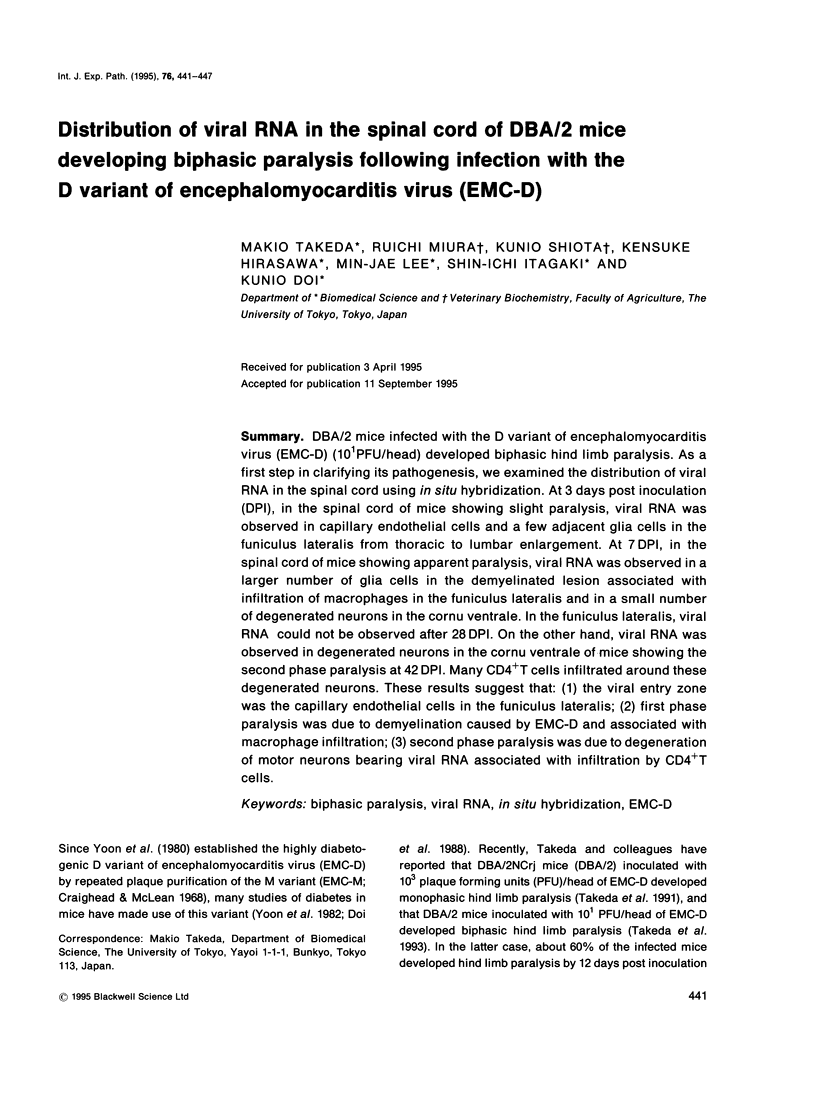
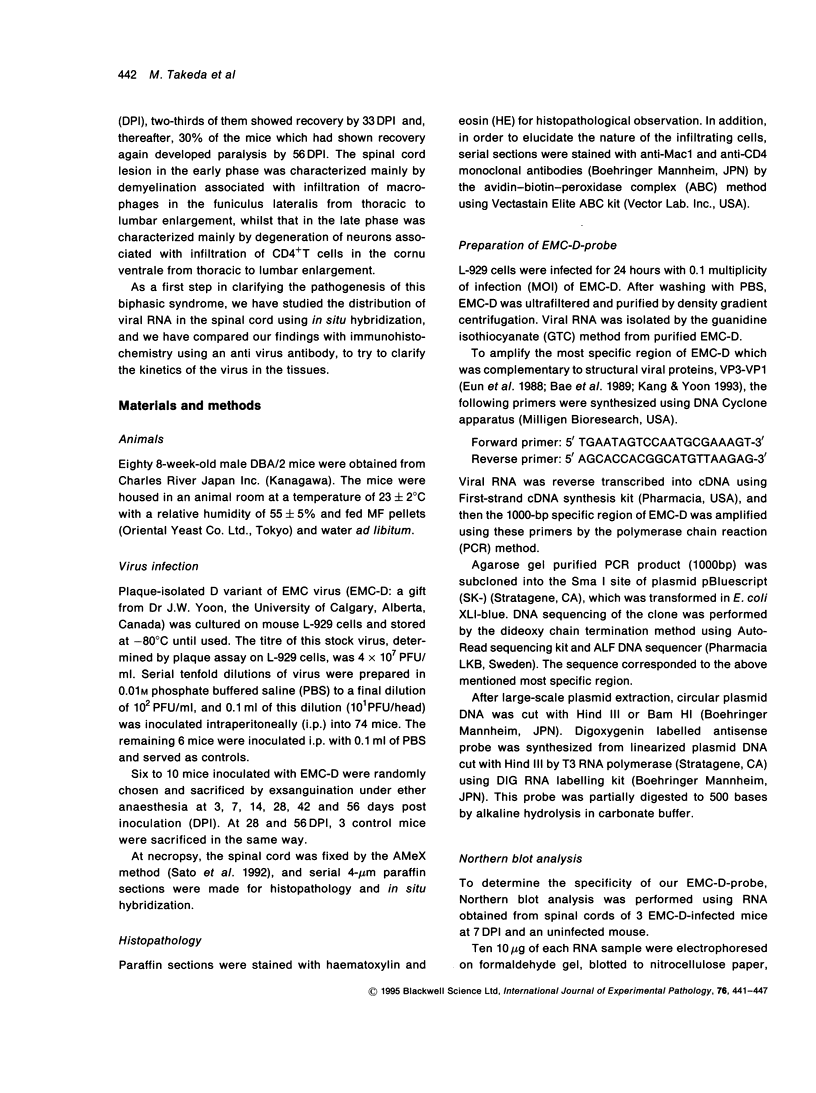
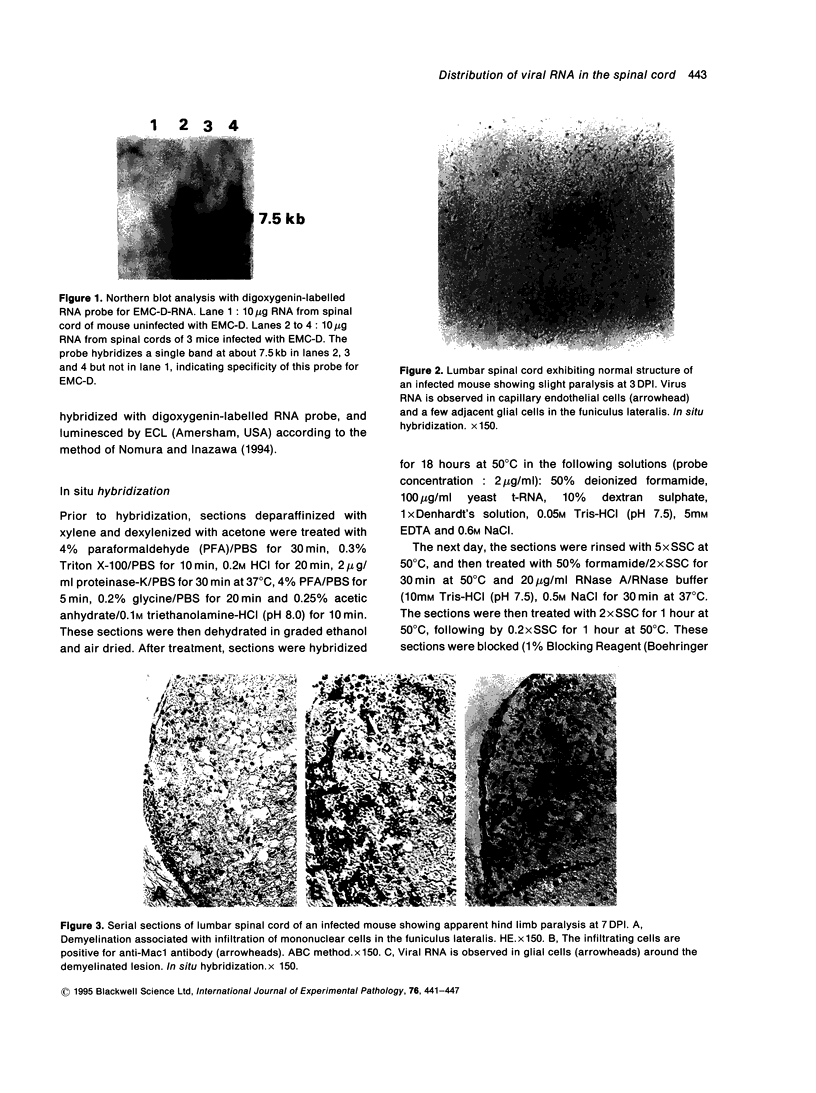
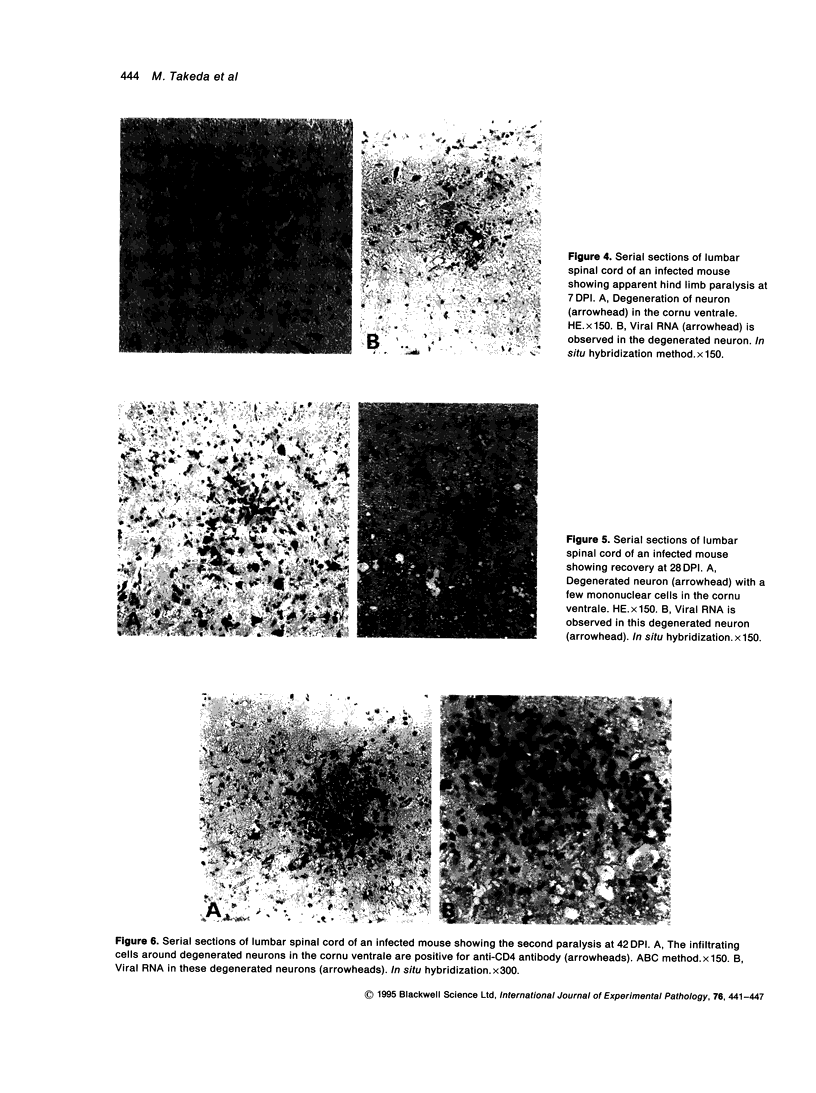
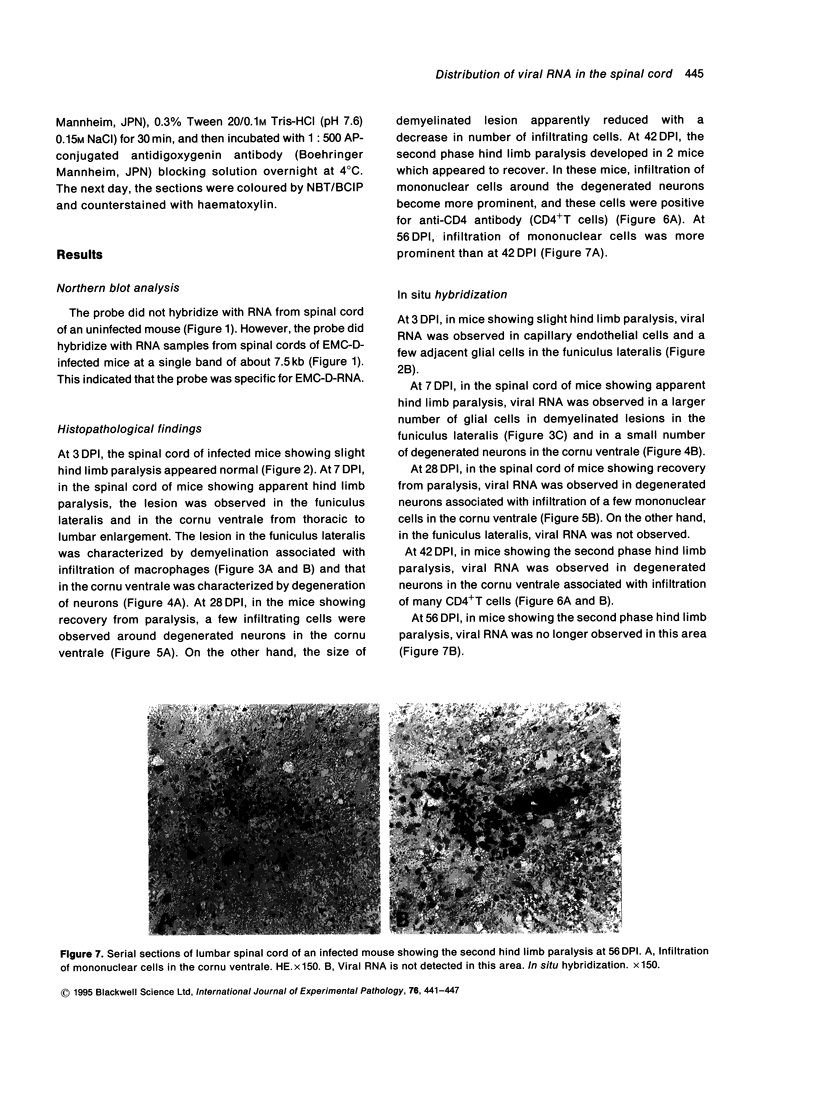
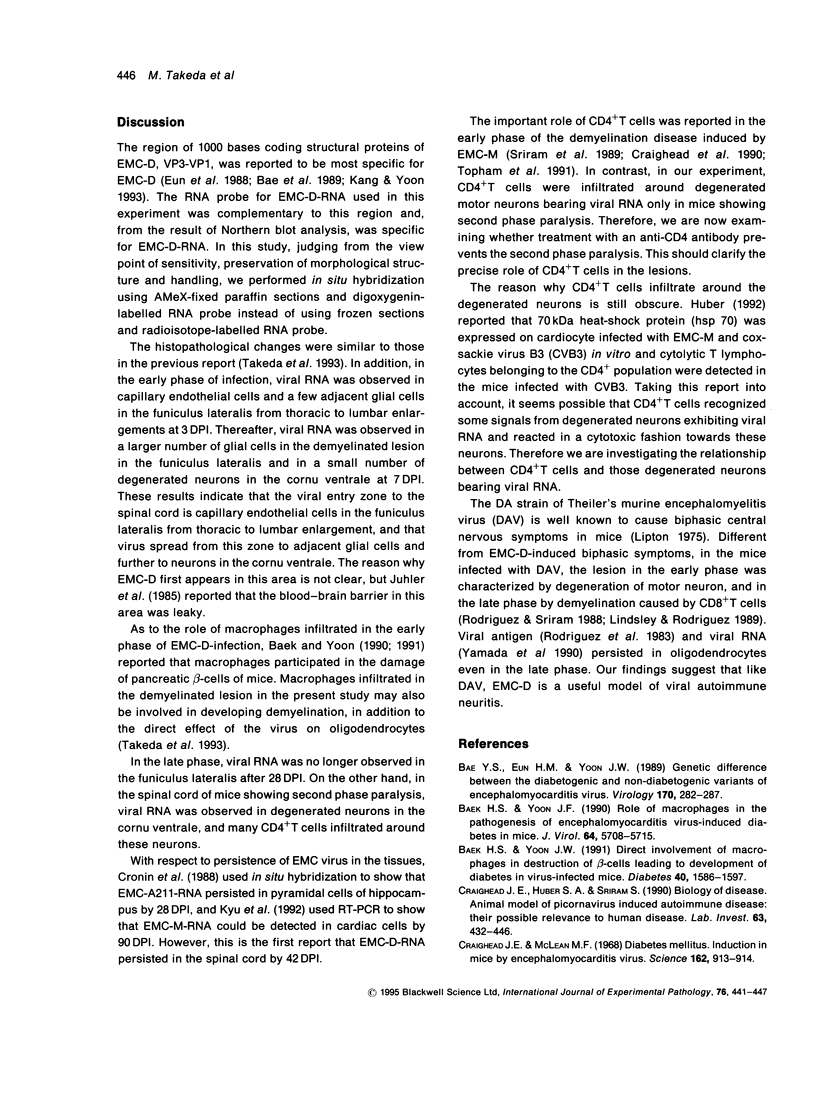

Images in this article
Selected References
These references are in PubMed. This may not be the complete list of references from this article.
- Bae Y. S., Eun H. M., Yoon J. W. Genomic differences between the diabetogenic and nondiabetogenic variants of encephalomyocarditis virus. Virology. 1989 May;170(1):282–287. doi: 10.1016/0042-6822(89)90379-6. [DOI] [PubMed] [Google Scholar]
- Baek H. S., Yoon J. W. Direct involvement of macrophages in destruction of beta-cells leading to development of diabetes in virus-infected mice. Diabetes. 1991 Dec;40(12):1586–1597. doi: 10.2337/diab.40.12.1586. [DOI] [PubMed] [Google Scholar]
- Baek H. S., Yoon J. W. Role of macrophages in the pathogenesis of encephalomyocarditis virus-induced diabetes in mice. J Virol. 1990 Dec;64(12):5708–5715. doi: 10.1128/jvi.64.12.5708-5715.1990. [DOI] [PMC free article] [PubMed] [Google Scholar]
- Craighead J. E., Huber S. A., Sriram S. Animal models of picornavirus-induced autoimmune disease: their possible relevance to human disease. Lab Invest. 1990 Oct;63(4):432–446. [PubMed] [Google Scholar]
- Cronin M. E., Love L. A., Miller F. W., McClintock P. R., Plotz P. H. The natural history of encephalomyocarditis virus-induced myositis and myocarditis in mice. Viral persistence demonstrated by in situ hybridization. J Exp Med. 1988 Nov 1;168(5):1639–1648. doi: 10.1084/jem.168.5.1639. [DOI] [PMC free article] [PubMed] [Google Scholar]
- Doi K., Matsuzaki H., Tsuda T., Onodera T. Rapid development of renal lesions in diabetic DBA mice infected with the D-variant of encephalomyocarditis virus (EMC-D). Br J Exp Pathol. 1989 Jun;70(3):275–281. [PMC free article] [PubMed] [Google Scholar]
- Huber S. A. Heat-shock protein induction in adriamycin and picornavirus-infected cardiocytes. Lab Invest. 1992 Aug;67(2):218–224. [PubMed] [Google Scholar]
- Juhler M., Blasberg R. G., Fenstermacher J. D., Patlak C. S., Paulson O. B. A spatial analysis of the blood-brain barrier damage in experimental allergic encephalomyelitis. J Cereb Blood Flow Metab. 1985 Dec;5(4):545–553. doi: 10.1038/jcbfm.1985.82. [DOI] [PubMed] [Google Scholar]
- Kang Y., Yoon J. W. A genetically determined host factor controlling susceptibility to encephalomyocarditis virus-induced diabetes in mice. J Gen Virol. 1993 Jun;74(Pt 6):1207–1213. doi: 10.1099/0022-1317-74-6-1207. [DOI] [PubMed] [Google Scholar]
- Kyu B., Matsumori A., Sato Y., Okada I., Chapman N. M., Tracy S. Cardiac persistence of cardioviral RNA detected by polymerase chain reaction in a murine model of dilated cardiomyopathy. Circulation. 1992 Aug;86(2):522–530. doi: 10.1161/01.cir.86.2.522. [DOI] [PubMed] [Google Scholar]
- Lindsley M. D., Rodriguez M. Characterization of the inflammatory response in the central nervous system of mice susceptible or resistant to demyelination by Theiler's virus. J Immunol. 1989 Apr 15;142(8):2677–2682. [PubMed] [Google Scholar]
- Lipton H. L. Theiler's virus infection in mice: an unusual biphasic disease process leading to demyelination. Infect Immun. 1975 May;11(5):1147–1155. doi: 10.1128/iai.11.5.1147-1155.1975. [DOI] [PMC free article] [PubMed] [Google Scholar]
- Rodriguez M., Leibowitz J. L., Lampert P. W. Persistent infection of oligodendrocytes in Theiler's virus-induced encephalomyelitis. Ann Neurol. 1983 Apr;13(4):426–433. doi: 10.1002/ana.410130409. [DOI] [PubMed] [Google Scholar]
- Rodriguez M., Sriram S. Successful therapy of Theiler's virus-induced demyelination (DA strain) with monoclonal anti-Lyt-2 antibody. J Immunol. 1988 May 1;140(9):2950–2955. [PubMed] [Google Scholar]
- Sriram S., Topham D. J., Huang S. K., Rodriguez M. Treatment of encephalomyocarditis virus-induced central nervous system demyelination with monoclonal anti-T-cell antibodies. J Virol. 1989 Oct;63(10):4242–4248. doi: 10.1128/jvi.63.10.4242-4248.1989. [DOI] [PMC free article] [PubMed] [Google Scholar]
- Takeda M., Hirasawa K., Doi K. Lesions in the central nervous system of DBA/2 mice infected with the D variant of encephalomyocarditis virus (EMC-D). J Vet Med Sci. 1991 Dec;53(6):1013–1017. doi: 10.1292/jvms.53.1013. [DOI] [PubMed] [Google Scholar]
- Takeda M., Itagaki S., Doi K. Biphasic disease of central nervous system induced in DBA/2 mice by the D variant of encephalomyocarditis virus (EMC-D). Int J Exp Pathol. 1993 Oct;74(5):493–499. [PMC free article] [PubMed] [Google Scholar]
- Topham D. J., Adesina A., Shenoy M., Craighead J. E., Sriram S. Indirect role of T cells in development of polioencephalitis and encephalomyelitis induced by encephalomyocarditis virus. J Virol. 1991 Jun;65(6):3238–3245. doi: 10.1128/jvi.65.6.3238-3245.1991. [DOI] [PMC free article] [PubMed] [Google Scholar]
- Yamada M., Zurbriggen A., Fujinami R. S. The relationship between viral RNA, myelin-specific mRNAs, and demyelination in central nervous system disease during Theiler's virus infection. Am J Pathol. 1990 Dec;137(6):1467–1479. [PMC free article] [PubMed] [Google Scholar]
- Yoon J. W., McClintock P. R., Onodera T., Notkins A. L. Virus-induced diabetes mellitus. XVIII. Inhibition by a nondiabetogenic variant of encephalomyocarditis virus. J Exp Med. 1980 Oct 1;152(4):878–892. doi: 10.1084/jem.152.4.878. [DOI] [PMC free article] [PubMed] [Google Scholar]
- Yoon J. W., Rodrigues M. M., Currier C., Notkins A. L. Long-term complications of virus-induced diabetes mellitus in mice. Nature. 1982 Apr 8;296(5857):566–569. doi: 10.1038/296566a0. [DOI] [PubMed] [Google Scholar]









